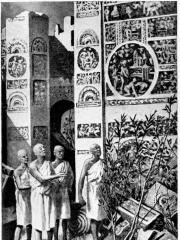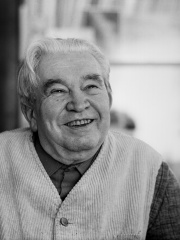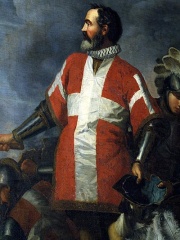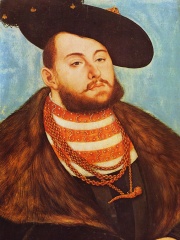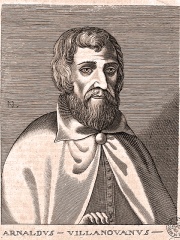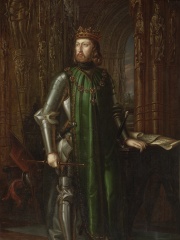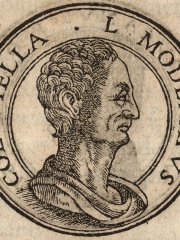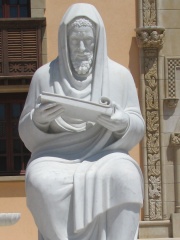WRITER
Leo Africanus
1494 - 1554

 Leo Africanus
Leo Africanus
Johannes Leo Africanus (born al-Ḥasan ibn Muḥammad ibn Aḥmad al-Wazzān al-Zayyātī al-Fasī, ; c. 1494 – c. 1554) was an Andalusi diplomat and author who is best known for his 1526 book Cosmographia et geographia de Affrica, later published by Giovanni Battista Ramusio as Descrittione dell'Africa (Description of Africa) in 1550, centered on the geography of the Maghreb and Nile Valley. The book was regarded among his scholarly peers in Europe as the most authoritative treatise on the subject until the modern exploration of Africa. For this work, Leo became a household name among European geographers. He converted from Islam to Christianity and changed his name to Johannes Leo de Medicis (Arabic: يوحنا الأسد, romanized: Yuḥannā al-Asad). Read more on Wikipedia
His biography is available in 43 different languages on Wikipedia. Leo Africanus is the 673rd most popular writer (down from 619th in 2024), the 203rd most popular biography from Spain (down from 179th in 2019) and the 20th most popular Spanish Writer.
Leo Africanus is most famous for his book, "The History and Description of Africa and of Its Inhabitants."
Memorability Metrics
Page views of Leo Africanus by language
Among WRITERS
Among writers, Leo Africanus ranks 673 out of 7,302. Before him are Luis de Góngora, Carlo Gozzi, Madame Roland, A. A. Milne, Magtymguly Pyragy, and Premchand. After him are Max Frisch, Bernard Gui, Longus, Faxian, Jaroslav Seifert, and Zecharia Sitchin.
Most Popular Writers in Wikipedia
Go to all RankingsLuis de Góngora
1561 - 1627
HPI: 70.93
Rank: 667
Carlo Gozzi
1720 - 1806
HPI: 70.91
Rank: 668
Madame Roland
1754 - 1793
HPI: 70.91
Rank: 669
A. A. Milne
1882 - 1956
HPI: 70.88
Rank: 670
Magtymguly Pyragy
1733 - 1807
HPI: 70.86
Rank: 671
Premchand
1880 - 1936
HPI: 70.83
Rank: 672
Leo Africanus
1494 - 1554
HPI: 70.83
Rank: 673
Max Frisch
1911 - 1991
HPI: 70.83
Rank: 674
Bernard Gui
1261 - 1331
HPI: 70.83
Rank: 675
Longus
110 - 200
HPI: 70.82
Rank: 676
Faxian
340 - 418
HPI: 70.81
Rank: 677
Jaroslav Seifert
1901 - 1986
HPI: 70.81
Rank: 678
Zecharia Sitchin
1920 - 2010
HPI: 70.81
Rank: 679
Contemporaries
Among people born in 1494, Leo Africanus ranks 10. Before him are Fuzûlî, Georgius Agricola, Pontormo, Bona Sforza, Rosso Fiorentino, and Jean Parisot de Valette. After him are Lucas van Leyden, Antoinette de Bourbon, Hans Sachs, William Tyndale, Oronce Finé, and Antonio de Mendoza. Among people deceased in 1554, Leo Africanus ranks 4. Before him are Lady Jane Grey, Piri Reis, and Francisco Vázquez de Coronado. After him are John Frederick I, Elector of Saxony, Sebastiano Serlio, João Manuel, Prince of Portugal, Henry Grey, 1st Duke of Suffolk, Sibylle of Cleves, Thomas Wyatt the Younger, Hieronymus Bock, and Pedro Cieza de León.
Others Born in 1494
Go to all RankingsFuzûlî
WRITER
1494 - 1556
HPI: 78.46
Rank: 4
Georgius Agricola
PHYSICIAN
1494 - 1555
HPI: 77.34
Rank: 5
Pontormo
PAINTER
1494 - 1557
HPI: 75.43
Rank: 6
Bona Sforza
POLITICIAN
1494 - 1557
HPI: 72.63
Rank: 7
Rosso Fiorentino
PAINTER
1494 - 1540
HPI: 71.75
Rank: 8
Jean Parisot de Valette
POLITICIAN
1494 - 1568
HPI: 71.65
Rank: 9
Leo Africanus
WRITER
1494 - 1554
HPI: 70.83
Rank: 10
Lucas van Leyden
PAINTER
1494 - 1533
HPI: 70.25
Rank: 11
Antoinette de Bourbon
POLITICIAN
1494 - 1583
HPI: 68.65
Rank: 12
Hans Sachs
WRITER
1494 - 1576
HPI: 68.56
Rank: 13
William Tyndale
RELIGIOUS FIGURE
1494 - 1536
HPI: 66.18
Rank: 14
Oronce Finé
MATHEMATICIAN
1494 - 1555
HPI: 64.67
Rank: 15
Antonio de Mendoza
POLITICIAN
1494 - 1552
HPI: 63.97
Rank: 16
Others Deceased in 1554
Go to all RankingsLady Jane Grey
NOBLEMAN
1537 - 1554
HPI: 88.92
Rank: 1
Piri Reis
GEOGRAPHER
1470 - 1554
HPI: 76.77
Rank: 2
Francisco Vázquez de Coronado
EXPLORER
1510 - 1554
HPI: 73.72
Rank: 3
Leo Africanus
WRITER
1494 - 1554
HPI: 70.83
Rank: 4
John Frederick I, Elector of Saxony
POLITICIAN
1503 - 1554
HPI: 70.49
Rank: 5
Sebastiano Serlio
ARCHITECT
1475 - 1554
HPI: 69.52
Rank: 6
João Manuel, Prince of Portugal
POLITICIAN
1537 - 1554
HPI: 69.26
Rank: 7
Henry Grey, 1st Duke of Suffolk
POLITICIAN
1517 - 1554
HPI: 68.26
Rank: 8
Sibylle of Cleves
POLITICIAN
1512 - 1554
HPI: 67.29
Rank: 9
Thomas Wyatt the Younger
POLITICIAN
1521 - 1554
HPI: 66.90
Rank: 10
Hieronymus Bock
BIOLOGIST
1498 - 1554
HPI: 63.63
Rank: 11
Pedro Cieza de León
EXPLORER
1520 - 1554
HPI: 62.25
Rank: 12
In Spain
Among people born in Spain, Leo Africanus ranks 203 out of 3,355. Before him are Peter II of Aragon (1174), Luis de Góngora (1561), Philip, Duke of Parma (1720), Alfonso VII of León and Castile (1105), Martin of Aragon (1356), and Pedro de Alvarado (1485). After him are Buenaventura Durruti (1896), Arnaldus de Villa Nova (1240), Raymond of Penyafort (1175), John I of Castile (1358), Alfonso IX of León (1171), and Ferdinand I of León (1016).
Others born in Spain
Go to all RankingsPeter II of Aragon
POLITICIAN
1174 - 1213
HPI: 70.97
Rank: 197
Luis de Góngora
WRITER
1561 - 1627
HPI: 70.93
Rank: 198
Philip, Duke of Parma
POLITICIAN
1720 - 1765
HPI: 70.91
Rank: 199
Alfonso VII of León and Castile
POLITICIAN
1105 - 1157
HPI: 70.86
Rank: 200
Martin of Aragon
POLITICIAN
1356 - 1410
HPI: 70.85
Rank: 201
Pedro de Alvarado
MILITARY PERSONNEL
1485 - 1541
HPI: 70.84
Rank: 202
Leo Africanus
WRITER
1494 - 1554
HPI: 70.83
Rank: 203
Buenaventura Durruti
SOCIAL ACTIVIST
1896 - 1936
HPI: 70.70
Rank: 204
Arnaldus de Villa Nova
PHILOSOPHER
1240 - 1311
HPI: 70.69
Rank: 205
Raymond of Penyafort
RELIGIOUS FIGURE
1175 - 1275
HPI: 70.66
Rank: 206
John I of Castile
POLITICIAN
1358 - 1390
HPI: 70.51
Rank: 207
Alfonso IX of León
POLITICIAN
1171 - 1230
HPI: 70.51
Rank: 208
Ferdinand I of León
POLITICIAN
1016 - 1065
HPI: 70.48
Rank: 209
Among WRITERS In Spain
Among writers born in Spain, Leo Africanus ranks 20. Before him are Juan Ramón Jiménez (1881), Gaius Julius Hyginus (-64), Joan Fuster (1922), Francisco de Quevedo (1584), Vicente Aleixandre (1898), and Luis de Góngora (1561). After him are Tirso de Molina (1579), Columella (4), Lucan (39), Judah Halevi (1079), Joseph of Anchieta (1534), and Antonio Machado (1875).
Juan Ramón Jiménez
1881 - 1958
HPI: 71.96
Rank: 14
Gaius Julius Hyginus
64 BC - 17
HPI: 71.89
Rank: 15
Joan Fuster
1922 - 1992
HPI: 71.38
Rank: 16
Francisco de Quevedo
1584 - 1645
HPI: 71.34
Rank: 17
Vicente Aleixandre
1898 - 1984
HPI: 71.07
Rank: 18
Luis de Góngora
1561 - 1627
HPI: 70.93
Rank: 19
Leo Africanus
1494 - 1554
HPI: 70.83
Rank: 20
Tirso de Molina
1579 - 1648
HPI: 70.39
Rank: 21
Columella
4 - 70
HPI: 70.39
Rank: 22
Lucan
39 - 65
HPI: 70.35
Rank: 23
Judah Halevi
1079 - 1141
HPI: 70.30
Rank: 24
Joseph of Anchieta
1534 - 1597
HPI: 69.43
Rank: 25
Antonio Machado
1875 - 1939
HPI: 69.23
Rank: 26









